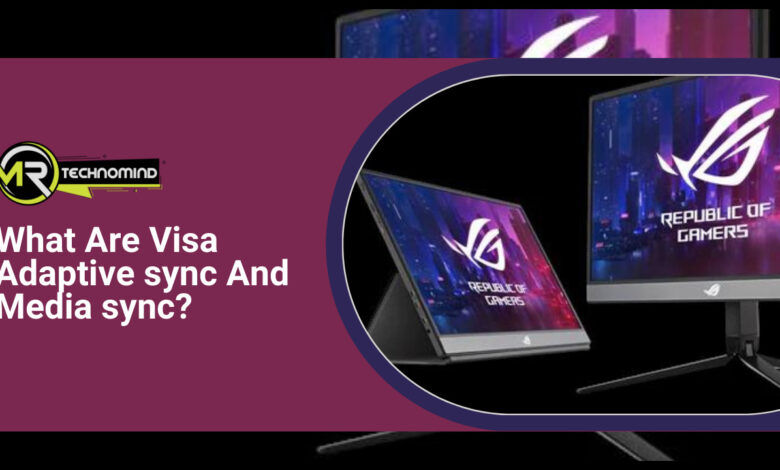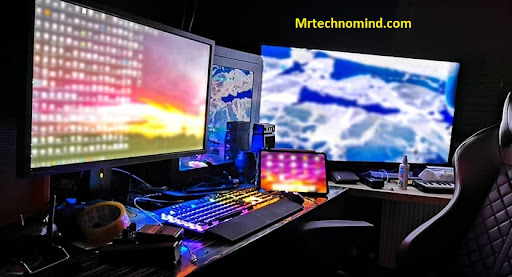What Are Visa Adaptive Sync and Media Sync?

AdaptiveSync and MediaSync are two types of technologies that are becoming increasingly popular in the world of digital displays. They improve the performance and usability of devices such as TVs, monitors, and projectors.
AdaptiveSync is a variable refresh rate technology developed by VESA (Video Electronics Standards Association). It ensures that frames displayed on a monitor match the refresh rate of the graphics card. This eliminates issues like screen tearing and stuttering, resulting in smoother visuals.
Meanwhile, MediaSync is open-source software designed to synchronize audio and video with external devices over USB or HDMI. It provides users with more control over their multimedia experience while also improving accuracy and reducing latency.
What is an Adaptive Sync Display?

AdaptiveSync display technology is a form of synchronization that enhances the gaming and viewing experience through improved refresh rates. It helps to eliminate screen tearing, stuttering, and input lag. This makes it an ideal choice for gamers seeking a smoother and more responsive experience while playing their favorite titles.
The technology synchronizes the refresh rate of a monitor with the video signals coming from the graphics card or processor in your computer. As the refresh rate changes, so does the actual frames per second (FPS). This ensures that data being sent to your monitor matches up perfectly with what’s happening inside your computer, resulting in an uninterrupted flow of visuals.
By delivering smooth visuals at higher resolutions, AdaptiveSync technology allows viewers and gamers to enjoy an immersive experience without any visual artifacts or disruptions. This is especially beneficial for gamers who want to take advantage of higher frame rates for even better responsiveness in their games.
Adaptive Sync Requirements
AdaptiveSync technology is a new way of providing smoother, faster gaming experiences. This technology uses the power of your graphics card and monitors together to deliver higher frame rates, lower latency, and improved refresh rates. The result is a much more responsive and immersive experience for gamers.
To take full advantage of this technology, both your monitor and graphics card must support it. AdaptiveSync requires a compatible display port connection in order to function. Many modern monitors come with either a VESA AdaptiveSync or an AMD FreeSync connection, which are both compatible with the technology. Additionally, some NVIDIA cards require an additional G-Sync module in order to utilize AdaptiveSync features.
All three options provide smooth, lag-free gaming experiences; however, there are differences between them that need to be considered when making a purchase decision. With all of this in mind, let’s look at how AdaptiveSync compares to FreeSync and G-Sync for gaming performance.
Adaptive Sync Vs Freesync Vs G-sync

AdaptiveSync, FreeSync, and G-SYNC are three of the most popular types of adaptive refresh rate technologies used to reduce screen tearing and improve gaming performance. They all provide a smoother gaming experience with reduced latency but differ in their implementation. Here’s how they compare:
| Adaptive-Sync | FreeSync | G-Sync | |
| Definition | A technology that syncs the refresh rate of the monitor with the output rate of the graphics card | AMD’s implementation of Adaptive-Sync | Nvidia’s implementation of Adaptive-Sync |
| Manufacturer | AMD, VESA (standard) | AMD | Nvidia |
| Cost | Affordable (included in most new monitors) | Free (license fee waived by AMD) | Expensive (leads to increased cost of compatible monitors) |
| Compatibility | Works with both AMD and Nvidia graphics cards | Works only with AMD graphics cards | Works only with Nvidia graphics cards |
| Range | Variable (depending on monitor and graphics card) | Varies by monitor | Variable (depending on monitor and graphics card) |
| Implementation | Uses DisplayPort, HDMI or both | Uses DisplayPort or HDMI | Uses DisplayPort |
| Smooth Performance | Can experience some occasional screen tearing or stuttering, but generally smooth performance | Generally smooth performance | Generally smooth perfo |
- **AdaptiveSync** is an open standard developed by VESA that allows for dynamic refresh rates across monitors and graphics cards. It works with any monitor that supports the technology and is available in both AMD and NVIDIA GPUs.
- **FreeSync** is a proprietary adaptive sync technology developed by AMD. It is only compatible with AMD graphics cards and selects monitors that have been certified by AMD as being capable of using FreeSync technology.
- **G-SYNC** is a proprietary adaptive sync technology developed by NVIDIA that employs its own dedicated hardware to synchronize the monitor’s refresh rate with the GPU’s output rate, resulting in smooth gameplay without tearing or stuttering.
The differences between these technologies can be subtle, but it’s important to understand them when choosing the best type of adaptive refresh rate for your needs. With this knowledge, you can make an informed decision on what type of display you need for your gaming setup.
Now that we know about AdaptiveSync vs FreeSync vs G-SYNC, let’s move on to exploring what MediaSync Display is all about!
What is Mediasync Display?

AdaptiveSync, FreeSync, and G-SYNC have all been discussed in the previous section. They are technologies that were created to provide smoother and more enjoyable gaming experiences on monitors with variable refresh rates.
Now let’s take a look at another technology that is related to these three: MediaSync Display.
MediaSync Display is a new type of display technology developed by VESA. This technology allows for seamless synchronization between video content and the display device so that what you see on the screen matches up perfectly with the source material. It also provides support for HDR (high dynamic range) content, which is becoming increasingly popular in the gaming industry.
By using a combination of advanced algorithms and hardware optimizations, MediaSync Display can ensure that all of your content appears exactly as intended – even if it’s from an older game or movie.
In addition to providing a better viewing experience, MediaSync Display also helps reduce input lag and improve response times. This makes it ideal for gamers who want to get the most out of their gaming sessions without having to worry about waiting for their monitor or TV to catch up with their actions on screen.
With all of these benefits, it’s easy to see why MediaSync Display has become increasingly popular among gamers looking for a better gaming experience.
Now we’ll explore what media sync requirements are needed in order to use this display technology effectively.
Media Sync Requirements
VESA AdaptiveSync and MediaSync are technologies used to ensure smooth, tear-free video playback. AdaptiveSync is a type of variable refresh rate technology that keeps the refresh rate of the display in sync with the frame rate of the content being shown on it. This helps to reduce input lag, improve visual quality, and decrease power consumption.
MediaSync is an extension of AdaptiveSync and adds additional features such as low latency playback, color accuracy, and support for multiple resolutions. MediaSync promises an improved gaming experience through faster refresh rates and smoother visuals with minimal lag time between inputs from the user and what’s displayed on the screen. It also provides better image quality along with support for 4K resolution at a 60Hz refresh rate which makes it ideal for watching movies or editing videos as well as playing games on high-end displays.
MediaSync requires a compatible display that supports both VESA AdaptiveSync and DisplayPort 1.2 or later connections. It also requires a graphics card with AMD’s FreeSync technology or NVIDIA’s G-SYNC technology installed, along with compatible drivers. Additionally, it requires monitoring firmware updates to enable support for Adaptive Sync.
Furthermore, all connected devices must be capable of transmitting data at the same speed in order for MediaSync to work properly.
Frequently Asked Questions
1. How Do I Know if My Monitor is Compatible With Adaptivesync or Mediasync?
AdaptiveSync and MediaSync are technologies developed by VESA, an organization that focuses on standards for display monitors.
To find out if your monitor is compatible with either of these technologies, you’ll want to check the specs of your monitor against what’s required for AdaptiveSync or MediaSync.
Usually, this information can be found on the manufacturer’s website or in the user manual.
It’s important to make sure your monitor meets the requirements for either technology because it can give you a better gaming experience and improved picture quality.
2. What Are the Benefits of Using Adaptivesync or Mediasync?
AdaptiveSync and MediaSync are both technologies designed to improve your gaming experience. By syncing the refresh rate of your monitor with the frame rate of your graphics card, they reduce screen tearing while also reducing input lag and improving overall performance.
This makes for a smoother and more responsive gaming experience, with less stuttering or ghosting across the screen. The technology also enables variable refresh rates, for an even more immersive experience.
3. Does Adaptivesync or Mediasync Affect the Performance of My Monitor?
Imagining a monitor on the brink of burning out, its performance deteriorating with every passing moment, it’s easy to see why AdaptiveSync and MediaSync are important.
These technologies provide a much-needed lifeline for your display, optimizing and maintaining its performance while increasing its longevity.
AdaptiveSync and MediaSync allow laptops, phones, and other devices to sync their refresh rate with the monitor, reducing screen tearing and stuttering as well as improving input lag and brightness consistency.
Without these technologies, you could be left with an unreliable monitor that can’t keep up with your needs.
4. Is Adaptivesync or Mediasync Available on All Computer Models
No, AdaptiveSync and MediaSync are not available on all computer models. They are specific technologies developed by VESA (Video Electronics Standards Association) that enable monitors to synchronize their refresh rate with the graphics card’s output.
This helps to eliminate screen tearing and stuttering, resulting in a smoother gaming experience or improved video playback. As such, these technologies require compatible hardware on both the monitor and computer for full functionality.
5. Are There Any Special Settings I Need to Configure to Enable Adaptivesync or Mediasync?
When it comes to enabling AdaptiveSync or MediaSync on your laptop, there’s no need to worry – provided your device is compatible with the technology.
Special settings don’t have to be configured; all you have to do is make sure that you have the latest drivers installed, and that you enable the feature in the system settings.
To illustrate just how simple it is, I recently upgraded my laptop’s graphics card and was able to start using AdaptiveSync within minutes!
Allowing me to enjoy smooth visuals and no screen tears.
Conclusion
AdaptiveSync and MediaSync are great tools for improving the performance of your monitor. With AdaptiveSync, you can enjoy smoother color transitions and higher refresh rates.
MediaSync allows for more vivid colors and better picture quality. Both of these technologies are easy to set up and configure. It’s like having a brand-new monitor without having to buy one!
Overall, AdaptiveSync and MediaSync are invaluable for anyone looking to improve the visuals on their monitor. They provide an immersive experience with stunning visuals that will make any gaming or movie night better than ever before.
Plus, they’re available on most computer models so you can easily take advantage of this technology no matter what kind of device you own. So don’t wait any longer – get AdaptiveSync or MediaSync today and enjoy the best visual experience possible!